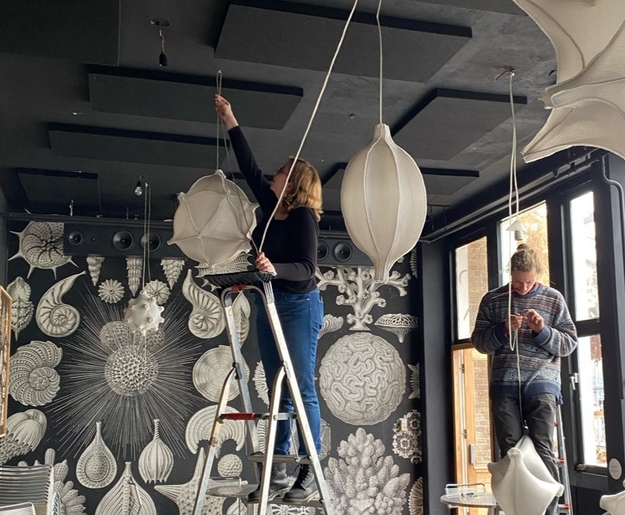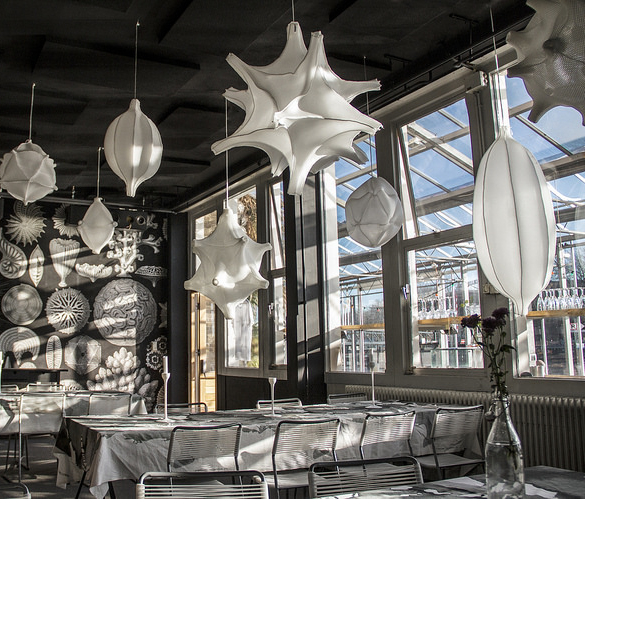Materials
When deciding on the correct cleaning method, a number of the object's aspects must be considered. For example, what is the texture and strength of the material?
The Radiolaria lamps are made of polyester fabric. The fabrics are shaped into two different textures: a thin, fine texture and a thicker honeycomb one. Both textures are loose and open, leaving plenty of room for dust and particles to settle into the fabric's tissue. Particles are often acidic by nature and when combined with high humidity could cause a chemical reaction and damage the material. Not to mention, dust and particles dull its color and presentation. Which is why it's necessary to occasionaly clean the objects more thoroughly. You won't be able to achieve the necessary result by vaccuuming alone. The vacuum cleaner won't be able to reach far enough through the thick, airy material of the honeycomb lamps to clean in between spaces as well as inside the fabric. Luckily, museumobjects' uncolored textiles are allowed to be washed. This can only be done by hand. Washing machines, dryers and irons cannot be used because it may damage the fabric.
Before washing the material, the object can be vacuumed. For this, a nylon cloth is placed around the vacuum cleaner's hose to decrease suction power, filter the vacuum cleaner and protect the fabric. In the event that the object has weak spots, this is additionally protected with a polyester or nylon fabric. It is then sewn loosely over the weak spot. However, the Radiolaria lamps are still in a good condition.
Size
The Radiolaria lamps are very large and washing it in a sink is therefore not an option. Instead, we used a large sterile cooking pan (which is cleaner and therefore safer than a basin) from our restaurant's kitchen. The lamps' polyester material requires a washing temperature of 40 ° C, which was constantly monitored through a thermometer. A bit of (odorless and colorless) detergent was then stirred into the pan. After soaking, the lamps were cleaned a couple of times to get the detergent out of the fabric.
Creative solutions
Normally, textile objects would then be placed on a sturdy form to support the textile, weakened by the water. But because the Radiolaria lamps are round and three-dimensional and may easily bend and dent, flattinging it isn't possible. At times like these, creative solutions have to be thought up. I had to leave the support behind, but instead I made sure that the lamps didn't touch another surfice. The lamps floated loose in the water and after washing I hung them by their tag on a clothes rack, where they could dry safely without chance of deforming.
Recommendations
An overview of the right care to the Radiolaria lamps:
-Remove dust semi-annually of annually with a vacuum cleaner. Cover the hose with a polyester or nylon cloth to protect the lamps.
-Wait to wash the lamps until absolutely necessary. This is in case of poor handling, an accident such as spilling on the fabric and/or when a lot of dust accumulates on the inaccessible areas of the lamps, causing the material to discolour.
-Never wash the lamps in the washing machine to avoid deformation. Hand wash the lamps in a sterile container or basin.
-Use only clean water and replace the water when it becomes discolored. Use a little detergent (1 teaspoon per liter) that is both odorless and colorless with a neutral Ph value. Wash the detergent thoroughly off the fabric with fresh water.
-Support the lamps with two nylon screens during washing and/or prevent the lamps from lying on top or against something, both during washing and drying.
-Dry the fabric with a hair dryer on a cool setting. Don't do anything with the lamps until they are completely dry.
Want to learn more?
Are you interested in learning more about the way museumobjects are handled and treated? The Canadian Conservation Institute (CCI), part of the Department of Canadian Heritage, has a wide range of information on the treatment of museumobjects: from paintings to vehicles and of plant materials to plastics and rubbers.
Sources
CCI Textile Lab (8 January 2020), 'Caring for Textiles and Costumes' Canadian Conservation Institute.
CCI Textile Lab (22 February 2019), 'Mechanical Surface Cleaning of Textiles' Canadian Conservation Institute.
CCI Textile Lab (22 February 2019), 'Washing Non-coloured Textiles' Canadian Conservation Institute.
Elize Laney (date unknown), 'Radiolaria – Tentaculus minimus' Gimmii Dutch Design.
Maite Quiles (2014), 'Radiolaria' Mediamatic.

